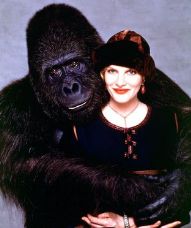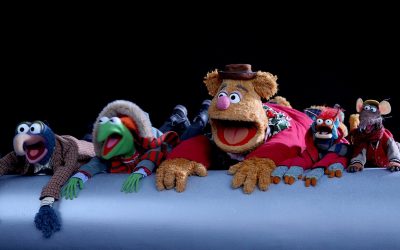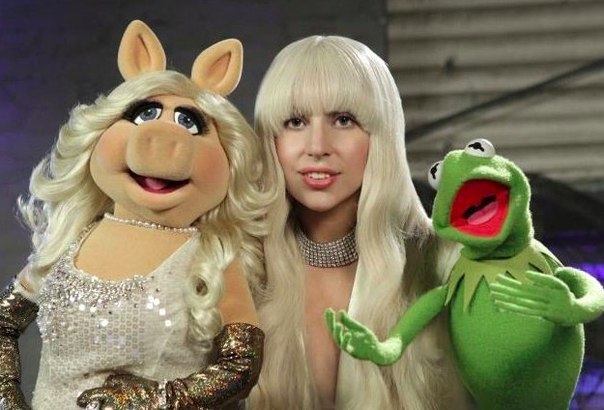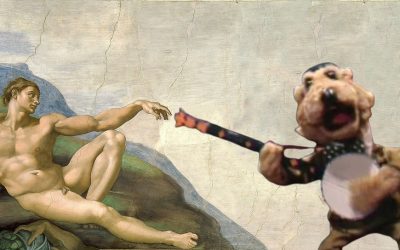Nutrition Facts
Serving Size: 1 cup (30g) and 1 movie (84 min’s)
Calories: 120
Calories from Fat: 10
Character Actors: 38
Ingredients: Whole Grain Oats, Cultural Imperialism, Marshmallow Bits, Sugar, Corn Syrup, Misunderstanding of Theory of Evolution, Corn Starch, Salt, Disdain for Ignorant Working Class, Calcium Carbonate, Trisodium Phosphate, Hypocrisy, Wheat Starch. Trailer advertising the same movie you’re currently watching added to DVD to preserve freshness.
Staring into a bowl of Lucky Charms transports you into a different and a dreadful world.
 It’s like being confronted with your own mortality. You know that it’s inevitable, and yet it seems unknowable, opening before you like a yawning chasm of unbeing. It is the worst fears that your subconscious ordinarily shields you from, made manifest and studded with colorful marshmallows. The idea that American children actually face down a bowl of Lucky Charms before heading out to elementary school fills me with the greatest respect for their sheer nerve and determination. They eat more breakfast before 7 am than most people do all day, and my hat is off to these brave little souls.
It’s like being confronted with your own mortality. You know that it’s inevitable, and yet it seems unknowable, opening before you like a yawning chasm of unbeing. It is the worst fears that your subconscious ordinarily shields you from, made manifest and studded with colorful marshmallows. The idea that American children actually face down a bowl of Lucky Charms before heading out to elementary school fills me with the greatest respect for their sheer nerve and determination. They eat more breakfast before 7 am than most people do all day, and my hat is off to these brave little souls.
When you pour a bowl of Lucky Charms, there’s a sudden sharp odor of concentrated sugar that immediately smacks you in the nose and takes up residence. You can literally smell it before you even sit down in the chair. Lucky Charms is not a cereal that sneaks up on you gently with a quiet murmur of snap, crackle and pop. It snaps at you, all right, but it snaps like a Venus flytrap in a Charles Addams cartoon. You want to count your appendages afterwards to make sure it didn’t take a finger.
But that’s not the bad thing. The bad thing is that while I raise this spoon of malevolent breakfast material to my lips, the DVD player is starting to play Buddy at me.
 Buddy is a movie that Jim Henson Pictures made in 1997 and is basically the entire explanation for why Jim Henson Pictures didn’t make any more movies. It starts out by saying “The Following is Based on a True Story,” but it’s based on a true story in the sense that a defense lawyer’s closing arguments are based on a true story. You have to read between the lines a bit.
Buddy is a movie that Jim Henson Pictures made in 1997 and is basically the entire explanation for why Jim Henson Pictures didn’t make any more movies. It starts out by saying “The Following is Based on a True Story,” but it’s based on a true story in the sense that a defense lawyer’s closing arguments are based on a true story. You have to read between the lines a bit.
Rene Russo plays Gertrude Lintz, a bored socialite lurking somewhere in the underbrush of 1931, dressing up the wildlife in hats and starched collars. As the movie opens, we find Gertrude at the movies, bringing along her two chimpanzees, Maggie Klein and Joe Mende. “Named after the Mende tribe,” she tuts at a confused usher. “Cannibals.” She raises one plucked eyebrow — enough said as far as Mrs Lintz is concerned — and that right there is pretty much your worldview for the next 84 minutes.
 She returns home from the movies, walks out onto the terrace of her richly appointed mansion, thrusts her head back, and begins to make the most unearthly ululating shrieks. She continues to make screechy faux-animal noises for a full minute, sounding for all the world like a one-woman Tarzan movie — all oo-oo-ack-ack and fakey bird trills. It’s what you think wild animals sound like if you’re eight years old and you live in Connecticut. This unholy racket somehow manages to attract a menagerie of animals, pretty much going down the probability scale from dogs and horses (possible) to raccoons and porcupines (not super likely to respond when you call them) and all the way down to — I kid you not — a Galapagos tortoise. For all I know, maybe paramecia and West Nile virus particles prick up their unicellular ears when this woman goes into her Snow White at the Gates of Hell routine. It’s a true story, after all.
She returns home from the movies, walks out onto the terrace of her richly appointed mansion, thrusts her head back, and begins to make the most unearthly ululating shrieks. She continues to make screechy faux-animal noises for a full minute, sounding for all the world like a one-woman Tarzan movie — all oo-oo-ack-ack and fakey bird trills. It’s what you think wild animals sound like if you’re eight years old and you live in Connecticut. This unholy racket somehow manages to attract a menagerie of animals, pretty much going down the probability scale from dogs and horses (possible) to raccoons and porcupines (not super likely to respond when you call them) and all the way down to — I kid you not — a Galapagos tortoise. For all I know, maybe paramecia and West Nile virus particles prick up their unicellular ears when this woman goes into her Snow White at the Gates of Hell routine. It’s a true story, after all.
 The chimpanzees are clothed and fed at the table like human children by Mrs Lintz’s housekeeping staff. She’s apparently operating under Standard Jewel in the Crown – Sun Never Sets on the British Empire Rules, in which animals are just like foreign people — they’re shorter and hairier than us, and they require a certain firmness of purpose when teaching them table manners, but in all other respects, they deserve to be treated with the same patience and understanding as our children, our servants and our houseplants. The basic hierarchy here is that well-bred white people are at the top, and everything else from retarded children to sea life is basically a lateral move. Apes and Mexicans, it’s all the same to Mrs Lintz. They can understand English when they choose to; you just have to speak very slowly and clearly to them or their attention will wander.
The chimpanzees are clothed and fed at the table like human children by Mrs Lintz’s housekeeping staff. She’s apparently operating under Standard Jewel in the Crown – Sun Never Sets on the British Empire Rules, in which animals are just like foreign people — they’re shorter and hairier than us, and they require a certain firmness of purpose when teaching them table manners, but in all other respects, they deserve to be treated with the same patience and understanding as our children, our servants and our houseplants. The basic hierarchy here is that well-bred white people are at the top, and everything else from retarded children to sea life is basically a lateral move. Apes and Mexicans, it’s all the same to Mrs Lintz. They can understand English when they choose to; you just have to speak very slowly and clearly to them or their attention will wander.
She gets a phone call and instantly whisks herself off to the Philadelphia Zoo in her fur-lined coat — her adoration for all animal life apparently not extending to our friends the ermines — where she ruthlessly browbeats a badly-shaven zoo employee with all the respect due to a degraded member of the human working classes. Apparently, the zoo employee has managed to acquire a sick baby gorilla that he doesn’t know how to care for; he acts like it just dropped off the back of a truck. “WHERE is his MOTHER?” cries Mrs Lintz, slipping oh-so-easily into full-on hysteria at a moment’s notice. “NO gorilla has EVER survived captivity without its mother. Not ONE. How did you expect HIM to?” The zoo employee stammers and shuffles his feet, so Mrs Lintz grabs the gorilla and announces, “I’m taking him HOME!”
The good thing about all this drama is that it’s taking my mind off the Lucky Charms. I’ve found that the little marshmallow bits should be swallowed whole if possible, as biting down on them releases a burst of super-sweet powder which coats my teeth with each bite. Thank goodness I’m distracted by the display of naked imperialism playing out on screen.
 Back at the ranch, lunch is served to the chimpanzees by the Lintzes’ cook. The cook is the only major black character in the movie, and her name is listed in the credits as “Emma.” Apparently she didn’t have a last name. Even the chimpanzees have last names in this movie. I can’t remember the last time I found a movie this offensive on this many levels, and I’m only up to minute 12.
Back at the ranch, lunch is served to the chimpanzees by the Lintzes’ cook. The cook is the only major black character in the movie, and her name is listed in the credits as “Emma.” Apparently she didn’t have a last name. Even the chimpanzees have last names in this movie. I can’t remember the last time I found a movie this offensive on this many levels, and I’m only up to minute 12.
For whatever reason, the parrot — who up to this point has only imitated animal cries — suddenly starts imitating the cook yelling at the apes to “get outta mah kitchen!” This startles the chimpanzees, who get excited and start jumping around and knocking over dishes. They hop up on the counters and start tossing a meat cleaver back and forth across the kitchen. The cook — who, I have to remind you, is the only major black character in the movie — goes and stands in the corner, with her eyes screwed shut and her hands clasped firmly over her ears. Thank goodness the white lady comes in to restore order at this point, and she calms the chimpanzees down — I swear to you that this part is true — by shaking a voodoo rattle and saying, “OOOOOO — he-eere comes the boogeyman!” I swear to you, she actually reaches over and pulls out this wooden stick topped with a voodoo skull and braided beads. The theory here apparently is that chimpanzees, like children and people of African descent, are superstitious and easily trained.
So why doesn’t Emma know how to use the voodoo stick when the chimps act up? I guess she’s too busy perfecting her Hattie McDaniels impression. A few minutes later, she actually rolls her eyes and says, “I got enough to do without chewin’ up food for monkeys!” This is the kind of role you just don’t see for black actresses anymore, thank goodness. My message for filmmakers: Just because your movie is set in 1931 doesn’t mean you have to pretend it was made in 1931.
 Anyway, that swarthy zoo manager may not have known what to do with a gorilla, but Mrs Lintz is going to do a little research, looking in a big leather bound book called WILD ANIMALS OF AFRICA. That’s not much help, so she goes to visit Professor Spatz at the Museum of Natural History. She’s taken aback by the dead animal heads that line Professor Spatz’s office, despite the fact that she herself is carrying a leather purse and wearing a fur-trimmed hat. He tells her that gorillas have no feelings beyond carnality and violence, but she determines to raise her gorilla like a human child, the same way that she does with her chimps. “That’s preposterous,” says Spatz, correctly. “Revolutionary as it might seem to you, I have encountered no limits or even real difficulties,” she snaps. “When they catch cold, do you have any idea what they need? Chicken soup.” That’s interesting, I desperately want the Professor to answer. What do you give the chickens?
Anyway, that swarthy zoo manager may not have known what to do with a gorilla, but Mrs Lintz is going to do a little research, looking in a big leather bound book called WILD ANIMALS OF AFRICA. That’s not much help, so she goes to visit Professor Spatz at the Museum of Natural History. She’s taken aback by the dead animal heads that line Professor Spatz’s office, despite the fact that she herself is carrying a leather purse and wearing a fur-trimmed hat. He tells her that gorillas have no feelings beyond carnality and violence, but she determines to raise her gorilla like a human child, the same way that she does with her chimps. “That’s preposterous,” says Spatz, correctly. “Revolutionary as it might seem to you, I have encountered no limits or even real difficulties,” she snaps. “When they catch cold, do you have any idea what they need? Chicken soup.” That’s interesting, I desperately want the Professor to answer. What do you give the chickens?
But, unfortunately, the characters refuse to talk sense to this despicable woman. In fact, the movie is venerating her, presenting her as supernaturally wise and uniquely connected to the natural world. The fact is that she’s the most spoiled, patronizing, psychotic imperialist dingbat who ever looked through her opera glasses at a landmass and said yes, I’ll have that, but could someone tidy it up a bit, please?
 This movie is not just unwatchable, it’s anti-watchable. I’m stunned that somebody actually thought it was a good idea to package this free with a box of breakfast cereal and show it to children first thing in the morning. I’m twenty minutes into this nightmare, and already I can feel the Lucky Charms doing irreparable harm to my teeth, and the movie doing the same to my respect for Western civilization.
This movie is not just unwatchable, it’s anti-watchable. I’m stunned that somebody actually thought it was a good idea to package this free with a box of breakfast cereal and show it to children first thing in the morning. I’m twenty minutes into this nightmare, and already I can feel the Lucky Charms doing irreparable harm to my teeth, and the movie doing the same to my respect for Western civilization.
I can’t take it anymore. I need to stop and go brush my teeth. Then I might change my name, join the French foreign legion, and try — just try — to forget.
Click here for Day One: Honey Nut Cheerios and Bear in the Big Blue House! Click here for Day Three: Cinnamon Toast Crunch and The Muppets Take Manhattan!
by Danny Horn




